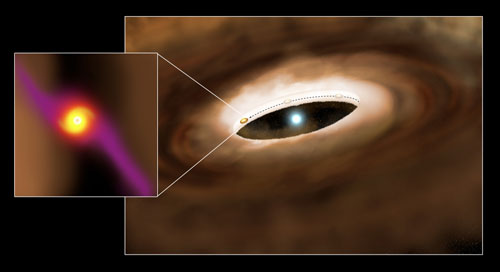| Sep 08, 2014 |
Scientist explores birth of a planet
|
|
(Nanowerk News) Dr. John Carr, a scientist at the U.S. Naval Research Laboratory (NRL), is part of an international team that has discovered what they believe is evidence of a planet forming around a star about 335 light years from Earth. This research is published in the August 20th issue of The Astrophysical Journal.
|
|
Carr and the other research team members set out to study the protoplanetary disk around a star known as HD 100546, and as sometimes happens in scientific inquiry, it was by "chance" that they stumbled upon the formation of the planet orbiting this star. A protoplanetary disk, or circumstellar disk, is a very large disk of material orbiting a newly formed star out of which a planetary system may form. The team was studying the warm gas in this disk using a technique called spectro-astrometry, which allows astronomers to detect small changes in the position of moving gas.
|
 |
| An artist's conception of the young massive star HD100546 and its surrounding disk. A planet forming in the disk has cleared the disk within 13AU of the star, a distance comparable to that of Saturn from the sun. As gas and dust flows from the circumstellar disk to the planet, this material surrounds the planet as a circumplanetary disk (inset). These rotating disks are believed to be the birthplaces of planetary moons, such as the Galilean moons that orbit Jupiter. While they are theoretically predicted to surround giant planets at birth, there has been little observational evidence to date for circumplanetary disks outside the solar system. Brittain et al. (2014) report evidence for an orbiting source of carbon monoxide emission whose size is consistent with theoretical predictions for a circumplanetary disk. Observations over 10 years trace the orbit of the forming planet from behind the near side of the circumstellar disk in 2003 to the far side of the disk in 2013. These observations provide a new way to study how planets form. (Image: P. Marenfeld & NOAO/AURA/NSF) (click on image to enlarge)
|
|
The researchers discovered an "extra" source of gaseous emission from carbon monoxide molecules that could not be explained by the protoplanetary disk alone. By tracking the changes in velocity and position of this extra emission over the years of the observations, they were able to show that it is orbiting around the young star. The distance from the star is somewhat larger than the distance of Saturn from the Sun. The evidence suggests that they are observing hot gas that surrounds an orbiting young planet. Carr points out that rather than seeing the planet directly, they are detecting the gas as it swirls around and onto the forming planet.
|
|
Through modeling carried out by Dr. Sean Brittain, a Clemson University astrophysicist and the lead author on the paper, and with additional data gathered by the team to confirm their initial hypothesis, they were able to investigate the extra emission as it orbited the star. The authors concluded that a likely explanation for the observations is a small circumplanetary disk of hot gas orbiting a forming planet. The candidate planet would be a gas giant at least three times the mass of Jupiter. The theory is that material from the large protoplanetary disk feeds into the circumplanetary disk, which then feeds onto the growing planet. Hence, a circumplanetary disk plays a mediating role in the growth of the planet. The remnants of a circumplanetary disk could also give birth to moons, such as those seen around Jupiter in our solar system. As Carr explains, a novel aspect of this new evidence for planet formation is the possible detection of a circumplanetary disk.
|
|
The team's study is based on four sets of observations gathered in 2003, 2006, 2010, and 2013. They used the Gemini Observatory and the Very Large Telescope at the European Southern Observatory, both located in Chile. The Gemini Observatory consists of twin 8.1-meter diameter optical/infrared telescopes located on mountains in Hawaii and Chile. The VLT is not just one telescope, but an array of four, each with a main mirror of 8.2 meters in diameter. The data were collected using high-resolution infrared spectrographs that allowed precise measurements of the motions of molecular gas surrounding the star.
|
|
"These results provide a rare opportunity," Carr says, "to study planet formation in action. Our analysis strongly suggests we are observing a disk of hot gas that surrounds a forming giant planet in orbit around the star. While such circumplanetary disks have been theorized to surround giant planets at birth and to control the flow of gas onto the growing planet, these findings are the first observational evidence for their existence. If our interpretation is correct, we are essentially seeing a planet caught in the act of formation."
|
|
Looking ahead, the team would like to continue to monitor the motion of the planet and obtain additional data to better define the properties of the circumplanetary disk. They predict that the planet and its disk will disappear from view in about two years time when they become hidden by the inner edge of the circumstellar disk. So, if the team's model is correct, the signature of the orbiting planet will not be seen for another 15 years until its orbit brings it back into view.
|
|
The research team consists of Dr. Sean Brittain, Clemson University; Dr. John S. Carr, Naval Research Laboratory, Remote Sensing Division; Dr. Joan R. Najita, National Optical Astronomy Observatory in Tucson, Arizona; and Dr. Sascha P. Quanz and Dr. Michael R. Meyer, both of ETH Zurich, Institute for Astronomy.
|

